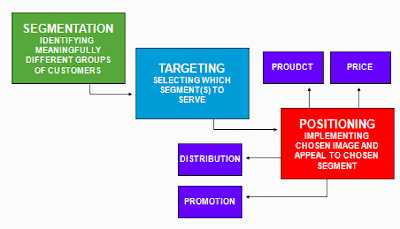Targeting & Positioning in Marketing
Target Marketing
In the next step, we decide to target one
or more segments. Our choice should generally depend on several factors.
First, how well are existing segments served by other manufacturers?
It will be more difficult to appeal to a segment that is already well served
than to one whose needs are not currently being served well. Secondly,
how large is the segment, and how can we expect it to grow? (Note that a
downside to a large, rapidly growing segment is that it tends to attract
competition). Thirdly, do we have strengths as a company that will help
us appeal particularly to one group of consumers? Firms may already have
an established reputation. While McDonald’s has a great reputation for
fast, consistent quality, family friendly food, it would be difficult to
convince consumers that McDonald’s now offers gourmet food. Thus, McD’s
would probably be better off targeting families in search of consistent quality
food in nice, clean restaurants.
It is possible using to target very specific customer
groups based on magazine subscriptions, past purchases, and demographic
variables. A number of list brokers will sell lists of names and
addresses of homeowners in a particular area (information they get from county
registrars) or the subscribers to various magazines. Firms will often sell
lists of their customers to competitors since it is widely believed in the
industry that more catalogs tend to result more in incremental sales than in
losing share in fixed-size pie. One can also buy e-mail lists, but it is
generally not legal to send soliciting e-mails to individuals with which one
does not already have an established business relationship, and these are also
likely to be discarded by "spam" filters. In the
"merge-purge" process, lists from several sources are combined (since
none contains every relevant individual by itself), after which duplicates are
removed. Here is an illustration of what could be used by an online
merchant of surf gear seeking to find additional potential customers:
Strategies for Reaching Target Markets
Marketers have outlined four basic strategies to satisfy target
markets: undifferentiated marketing or mass marketing, differentiated
marketing, concentrated marketing, and micromarketing or niche marketing.
1. Mass marketing - Mass marketing is a market
coverage strategy in which a firm decides to ignore market segment differences
and go after the whole market with one offer. It is the type of marketing (or
attempting to sell through persuasion) of a product to a wide audience. The
idea is to broadcast a message that will reach the largest number of people
possible.
2. Differentiated marketing - A
differentiated marketing strategy is one where the company decides to provide
separate offerings to each different market segment that it targets. It is also
called multi segment marketing. Each segment is targeted uniquely as the
company provides unique benefits to different segments.
3. Concentrated marketing - Concentrated marketing is a
strategy which targets very defined and specific segments of the consumer
population.
4. Niche
marketing - In marketing, a niche refers to a service or a
product that occupies a special area of demand. It is that small corner in the
market that accounts for a certain kind of specialty concerning an unmet
customer need. Niche marketing is the process of finding market segments that
are small but potentially profitable nonetheless.
Positioning
Positioning involves implementing our
targeting. For example, Apple Computer has chosen to position itself as a
maker of user-friendly computers. Thus, Apple has done a lot through its
advertising to promote itself, through its unintimidating icons, as a computer
for “non-geeks.” The Visual C software programming language, in contrast,
is aimed a “techies.”
Michael Treacy and Fred Wiersema suggested in their 1993
book The Discipline of Market Leaders that most successful
firms fall into one of three categories:
- Operationally
excellent firms,
which maintain a strong competitive advantage by maintaining exceptional
efficiency, thus enabling the firm to provide reliable service to the
customer at a significantly lower cost than those of less well organized
and well run competitors. The emphasis here is mostly on low cost,
subject to reliable performance, and less value is put on customizing the
offering for the specific customer. Wal-Mart is an example of this
discipline. Elaborate logistical designs allow goods to be moved at
the lowest cost, with extensive systems predicting when specific
quantities of supplies will be needed.
- Customer
intimate firms,
which excel in serving the specific needs of the individual customer
well. There is less emphasis on efficiency, which is sacrificed for
providing more precisely what is wanted by the customer. Reliability
is also stressed. Nordstrom’s and IBM are examples of this
discipline.
- Technologically
excellent firms,
which produce the most advanced products currently available with the
latest technology, constantly maintaining leadership in innovation.
These firms, because they work with costly technology that need
constant refinement, cannot be as efficient as the operationally excellent
firms and often cannot adapt their products as well to the needs of the
individual customer. Intel is an example of this discipline.








When it comes to positioning yourself, you need to do more. For example, with a video agency expert, you can leverage that to create a big following and get paid for years to come for the work that's done just once.
ReplyDeleteThanks for haring this very good info about roles of marketing, I am also doing my PGCM course from distance
ReplyDeletelearning center and i found this info very useful, thanks for sharing, keep sharing.
Great post! Impressed by Fielmente's work! As a Restaurant Marketing Company, they understand exactly what restaurants need to attract and retain customers in today’s digital-first world. Visit us for more!
ReplyDeleteReastaurent Marketing Company
Great post! Fielmente as a Reastaurent Marketing Firm truly understands the hospitality industry. Their strategies are creative and result-driven, helping restaurants build strong customer connections and sustainable growth. Visit us for more!
ReplyDeleteReastaurent Marketing Firm